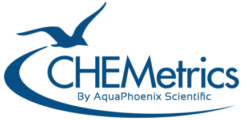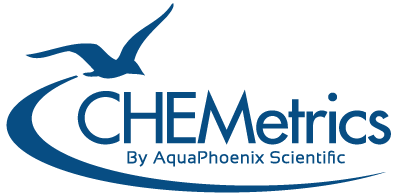Nitrite Test Kits

What is Nitrite?
Nitrite is an intermediate ion in the nitrogen cycle with the chemical formula (NO2–). It is formed during the decomposition of organic matter but readily oxidizes to form nitrate (NO3–). Due to this rapid oxidative conversion, nitrite is a very short-lived ion and is typically found in low concentrations naturally. Nitrites enter water naturally from mineral deposits and organic decay or artificially from fertilizer run-off and sewage. As a short-lived ion in the nitrogen cycle, measurements of nitrite provide valuable information about the nitrification and denitrification processes in a system.
Why Test for Nitrite?
In environmental applications, nitrite testing can help determine if a body of water is enriched with nutrients signaling it is approaching a eutrophic state. Eutrophication can lead to toxic algae blooms which deplete oxygen. The resulting hypoxia damages the ecosystem and can cause fish or shellfish kills. By measuring nitrite at different watershed locations, pollution point sources can be identified before an algae bloom begins.
For drinking water a Maximum Contaminant Level of 1 mg/L has been established by the USEPA for nitrite-nitrogen.
Sodium nitrite is often a key component of corrosion inhibitors for boiler and chiller systems. Nitrite’s oxidizing property inhibits corrosion by promoting the formation of a passive iron oxide film on steel surfaces. Testing nitrites in water levels in boilers and chillers helps identify conditions that may cause corrosion leading to expensive maintenance. Additionally, drops in nitrite level may signal the presence of nitrifying bacteria that use nitrite as a food source, prompting operators to schedule system maintenance.
About Our Test Kits
CHEMetrics visual nitrite test kits feature CHEMets® self-filling ampoules that contain pre-measured reagent for a single test. Simply snap the ampoule directly in a sample to draw in the correct volume of sample and then compare to the supplied color standards to find the concentration. CHEMetrics CHEMets test kits utilize the Azo Dye Formation chemistry.
CHEMetrics also offers a visual Titrets® test kit which features a reverse titration to replace and simplify lengthy drop count test procedures. These kits utilize a ceric sulfate titrant with a ferroin indicator.
CHEMetrics instrumental nitrite test kits feature Vacu-vials® ampoule technology. Vacu-vials ampoules utilize the same self-filling technology as CHEMets ampoules, but the vials have a 13mm diameter, so they are compatible with most photometers or spectrophotometers.
Click on a catalog number in the tables below for more information or to purchase a nitrites in water test kit.
Visual Kits
| Range | MDL | Method | Kit Catalog No. | Refill Catalog No. |
|---|---|---|---|---|
| 0 - 0.1 & 0 - 1 ppm as N | 0.005 ppm | Azo Dye Formation (NED) | K-7006 | R-7006 |
| 0-2.5 ppm as N | 0.2 ppm | Azo Dye Formation | K-7004 | R-7002 |
| 0-300 ppm as N | 20 ppm | Azo Dye Formation | K-7004B | R-7002B |
| 0-3000 ppm as N | 200 ppm | Azo Dye Formation | K-7004C | R-7002C |
| 250-2500 ppm as NaNO₂ | 250 ppm | Ceric Sulfate Titrant with Ferroin Indicator | K-7025 | |
| 500-5000 ppm as NaNO₂ | 500 ppm | Ceric Sulfate Titrant with Ferroin Indicator | K-7050 |
Instrumental Kits
| Range | Method | Kit Catalog No. |
|---|---|---|
| 0 - 0.750 ppm as N | Azo Dye Formation (NED) | K-7013 |
| 0-1.00 ppm as N | Azo Dye Formation | K-7003 |
Methods
Reference: APHA Standard Methods, 23rd ed., Method 4500-NO2¯ B- 2000. USEPA Methods for Chemical Analysis of Water and Wastes, Method 354.1 (1983). Nitrite diazotizes with a primary aromatic amine in an acidic solution to produce a highly colored azo dye. The intensity of the color is directly proportional to the concentration of nitrite in the sample. Use of the primary aromatic amine N-(1-naphthyl)ethylenediamine dihydrochloride (NED) with this method allows for lower range testing and improved sensitivity. Nitrate will not interfere. Results are expressed as ppm (mg/L) NO2-N.
Reference: Developed by CHEMetrics, LLC Ceric sulfate is the titrant and ferroin is the end point indicator. The method is free from glycol interference in samples that contain up to 75% glycol, making it particularly applicable to systems that contain nitrite corrosion inhibitors. Results are expressed as ppm (mg/L) NaNO2.

